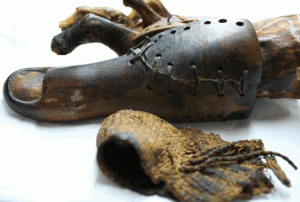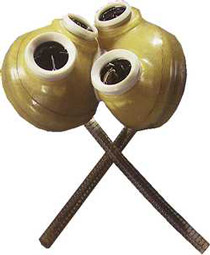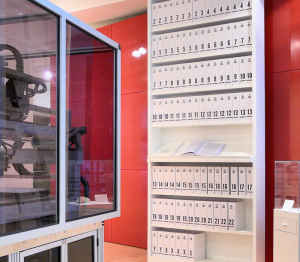A Brief History of Health Technology
In the very broadest sense, the history of medical and health technology is anything but brief. In fact, it was recently confirmed that the world’s oldest prosthetic devices were Egyptian wooden and leather toes that dated back to as early as 950 BC! And, as a senior editor for the blog Medgadget, it’s my mission to chronicle the latest health technology, which has included a whopping 12,000 news pieces and counting in just eight years!
While there’s a lot of significant events in the history of medical technology, I thought I’d attempt to share a few that I think are not only meaningful, but also interesting.
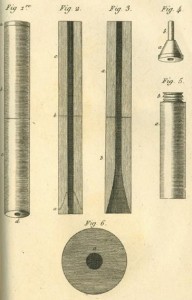
An early version of the stethoscope
1816 – Doctor René Laennec develops stethoscope out of respect for women: French physician René Laennec is a true gentleman and the quintessential engineer. When attempting to diagnose a patient with a heart condition, he applied his basic knowledge of acoustics, rolling up a newspaper and placing in on the patient’s chest. This early stethoscope allowed Laennec to much more clearly hear the heart sounds of the patient. It also allowed him to maintain his dignity, as the patient was a woman, and placing his ear on her bare chest was considered immodest.

First medical X-ray
1895 – William Röntgen “accidentally” discovers that X-rays are medically useful: It’s said that one day, German physicist Wilhelm Röntgen was playing around with cathode tubes when he observed that a nearby fluorescent screen was being illuminated by invisible rays (which he coined “Röntgen rays” at first) that could pass through different materials. He didn’t realize the real practicality of them, however, until he made a picture of his wife’s hand using X-rays and a photographic plate. Fortunately, Frau Röntgen didn’t turn into the Hulk, but her bony left hand and wedding band become a part of the very first X-ray photograph of a human body part, to which she exclaimed “I have seen my death!”
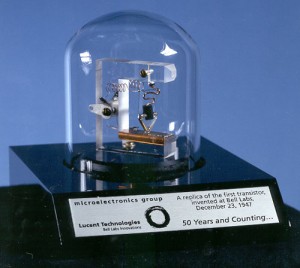
First transistor
late 1940’s – Transistors pave the way for faster computers and smaller implants: The development of the transistor is usually credited to a trio of researchers from Bell Labs and is a key component in virtually every electronic device. It was because of the advancement of the transistor that many medical devices that were once impractical to use because of their size and power requirements are even taken for granted. The implantable pacemaker, a commonplace, lifesaving device, has benefited much from transistor technology, and has shrunk over the years to a minuscule 20 millimeters. You can also thank the exponential advancement of the transistor (a phenomenon known as “Moore’s Law”) for “forcing” you to buy a new iPhone every year.
1956 – Thanks to dummies, a patent is issued for the first artificial, mechanical heart: While the Jarvik-7 and its successors are the most well-known artificial hearts, it wasn’t the first to be patented. One day at Montefiore Hospital in New York, Dr. Henry Heimlich (the creator of the Heimlich Maneuver/abdominal thrusts) invited his friend Paul Winchell to observe an open-heart surgery. After watching the patient expire during the surgery, he used his knowledge of dummies to come up with the concept of the artificial heart. You likely know Winchell as a popular ventriloquist and the voice of Tigger. (Fun fact: Winchell became friends with Heimlich after beating Ricardo Montalban in a televised dance competition, which led to the dinner where Winchell and Heimlich would first meet). To this day, a completely implantable artificial heart remains one of the holy grails of medical engineering.
 1980 – The World Wide Web is created, soon evolving to include videos of cats, tweets, and Rock Health ideas: Over at CERN in Switzerland, Tim Berners-Lee created the first “website”, which was a personal database of people and software models. Since that first website debuted, technology has advanced and the web has grown to include information of all sorts, from the completely bizarre to the infinitely useful. One thing that hasn’t changed, however, is its aim to present information and connect people. The era of digital health owes much to the rise of the internet, as popular health sites such as WebMD would not be in existence without it. Many of our current class and alumni companies also utilize the latest in web technologies in the same way: presenting useful information to doctors and their patients, and connecting them together to live better lives.
1980 – The World Wide Web is created, soon evolving to include videos of cats, tweets, and Rock Health ideas: Over at CERN in Switzerland, Tim Berners-Lee created the first “website”, which was a personal database of people and software models. Since that first website debuted, technology has advanced and the web has grown to include information of all sorts, from the completely bizarre to the infinitely useful. One thing that hasn’t changed, however, is its aim to present information and connect people. The era of digital health owes much to the rise of the internet, as popular health sites such as WebMD would not be in existence without it. Many of our current class and alumni companies also utilize the latest in web technologies in the same way: presenting useful information to doctors and their patients, and connecting them together to live better lives.
2000 – The Human Genome Project accelerates the rise in personalized medicine: In a collaboration between the U.S. Department of Energy, the National Institute of Health, and numerous other research institutions, the HGP sought to identify the 25,000 genes of a human genome. One of the many applications of this massive project, which are still being explored 13 years later, include a more comprehensive, genetic understanding of disease which can lead to a more individualized treatment of patients.
If you’re interested in more health tech history, check out this timeline of health technologies from the National Academy of Engineering. Also, be sure to check out Medgadget’s archives of medical lore from “the good old days”.
